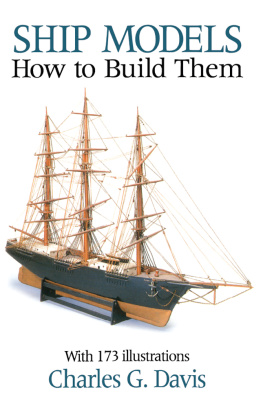Jacobs - Miniature ship models: a history and collectors guide
Here you can read online Jacobs - Miniature ship models: a history and collectors guide full text of the book (entire story) in english for free. Download pdf and epub, get meaning, cover and reviews about this ebook. City: Barnsley, year: 2008, publisher: Seaforth Publishing, genre: History. Description of the work, (preface) as well as reviews are available. Best literature library LitArk.com created for fans of good reading and offers a wide selection of genres:
Romance novel
Science fiction
Adventure
Detective
Science
History
Home and family
Prose
Art
Politics
Computer
Non-fiction
Religion
Business
Children
Humor
Choose a favorite category and find really read worthwhile books. Enjoy immersion in the world of imagination, feel the emotions of the characters or learn something new for yourself, make an fascinating discovery.
Miniature ship models: a history and collectors guide: summary, description and annotation
We offer to read an annotation, description, summary or preface (depends on what the author of the book "Miniature ship models: a history and collectors guide" wrote himself). If you haven't found the necessary information about the book — write in the comments, we will try to find it.
Jacobs: author's other books
Who wrote Miniature ship models: a history and collectors guide? Find out the surname, the name of the author of the book and a list of all author's works by series.
Miniature ship models: a history and collectors guide — read online for free the complete book (whole text) full work
Below is the text of the book, divided by pages. System saving the place of the last page read, allows you to conveniently read the book "Miniature ship models: a history and collectors guide" online for free, without having to search again every time where you left off. Put a bookmark, and you can go to the page where you finished reading at any time.
Font size:
Interval:
Bookmark:

Thomas Schroeders excellent rendition of the liner Manhattan (by CM) with neutrality markings
THOMAS SCHROEDER COLLECTION
Copyright Paul Jacobs 2008
First published in Great Britain in 2008 by
Seaforth Publishing
An imprint of Pen & Sword Books Ltd
47 Church Street, Barnsley
S Yorkshire S70 2AS
www.seaforthpublishing.com
Email
British Library Cataloguing in Publication Data
A CIP data record for this book is available from the British Library
ISBN 978-1-84832-003-1
PDF ISBN: 978-1-78346-537-8
EPUB ISBN: 978-1-78383-003-9
PRC ISBN: 978-1-78346-770-9
All rights reserved. No part of this publication may be reproduced or transmitted in any form
or by any means, electronic or mechanical, including photocopying, recording, or any
information storage and retrieval system, without prior permission in writing of both the
copyright owner and the above publisher.
The right of Paul Jacobs to be identified as the author of this work has been asserted by him in
accordance with the Copyright, Designs and Patents Act 1988.
Designed and Typeset by Roger Daniels
Printed and bound in China
To my wife Renee
who has supported and encouraged me in the hobby these many years
CONTENTS

One of the great advantages of miniature scales is that large numbers of models can be housed in very restrictive spaces. This filing cabinet drawer is full of models of British cruisers and small aircraft carriers (with the superstructure of the Hermes lying unpainted on her flight deck). A small part of the collection of the master model maker Peter Ohm, they are in various stages of completion and painting.
PETER OHM COLLECTION
FOREWORD
O N A BRIGHT SUNNY DAY IN EARLY September 1957, I walked with great anticipation into Vaughns department store in downtown Chicago and ran up a flight of stairs to the second floor. There I found table-top display cases filled with fleets of small metal ships. This was a dream come true. I was eleven years old and had never seen anything like it.
I had managed to obtain four or five similar models here and there in the preceding years, but I had no idea where they could be found and that so many different ones were available to buy. A friend and I used these models to fight naval battles on the linoleum-tile floor of my den, until one day he called me to tell me that he had discovered hundreds of them in a store in Chicago. The models in the cases were all made by Comet-Authenticast, and above and behind the cases were shelves lined with the uniform red, white, and blue boxes in which more were packaged. That day I purchased a U-boat and a British sloop, for the grand sum of $1.10.
That day has stuck in my mind for the past fifty years as a fond memory of the beginning of a hobby that has been both a passion and a comfort these many years. Over the years I have learned to build and convert models, and finally to produce my own line of models for commercial sales.
In the writing of this book, I have finally learned something important about the lives of those who started this hobby and who nurture it today. The most amazing discovery to me was just how closely connected many of the key players are or have been. It is almost like a small town where the inhabitants can trace their roots to the same ancestors.
I could not have written this book without the gracious assistance of many others. I want to thank Michael Seeber, Bryan Brown, Manfred Schutt, James Sprouse, John Reeder, Peter Wiedling, Peter Krtina, and all those who contributed photographs.
Thank you also to Derek Head who graciously allowed me to use material from his very fine book, Bassett-Lowke Ship Models, and Edward von der Porten, who gave hours of his time to help edit and correct grammar and punctuation. Fred Doris provided significant assistance with regard to the history of the United States militarys identification models in the two world wars, and Richard Pattee provided significant help in regard to the history of the hobby from its inception to the present as well as his own personal knowledge of some of the pioneers of the hobby.
INTRODUCTION
F ROM THE TIME THAT MAN FIRST ventured to sea, he created miniature replicas of his boats and ships. The earliest preserved replicas, which we would call models, were made of wood and have been found in the tombs of Egyptian pharaohs and nobles. The ancient Greeks also made models of their ships, beginning in the Bronze Age. These were made of lead, clay, stone, bronze, iron and wood. Some were votive and burial offerings, others oil lamps, firedogs, drinking vessels, decorations, and toys. Bronze-Age Scandinavians made large ship models as part of their sun cult, which envisioned the sun travelling under the earth each night in a boat. They peopled their models with guardian human and animal figurines made of bronze, some of which were figureheads and others divine crewmen and axe-wielding warriors wearing horned helmets. The Iron-Age Scandinavians, better known as Vikings after their most spectacular era, made many wooden ship models, most of them toys, but some large ones likely used in religious contexts.
Ship model making continued into Europes Middle Ages. Models were dedicated in churches as gift offerings by sailors, nobles, kings and queens, with the earliest surviving examples dating back to the late fourteenth century. They were usually made of wood, but the finest were of silver, as were incense boats and reliquaries of saints associated with the sea. At the same time, elaborate silver ship models and some of gold embellished with gems and enamels were made as drinking cups, salt cellars, and ornaments to grace the tables of kings and nobles.
The tradition of ship modelling continued through the Renaissance and into the seventeenth century, ranging from small silver models worn by captains wives during the Dutch Golden Age, through the completely rigged and gilded little ship mounted on a wheeled carriage made by shipwright Phineas Pett for Prince Charles (later King Charles II), to the model of the Sovereign of the Seas created by Pett for King Charles I so he could examine it before ordering construction to begin. During the latter part of the seventeenth century, and into the mid-eighteenth century, the Royal Dockyards built models for the British Admiralty, some of which can be seen in museum collections, such as the one at The National Maritime Museum in Greenwich, England. Samuel Pepys amassed a collection of these models, as did his successor Charles Sergison, some of which are now housed in the US Naval Academy Museum at Annapolis, Maryland. Unlike many of the models which came before them, these were precise and exact scale replicas. Similar models became common throughout western Europe.
For thousands of years all ship models shared certain common aspects. Whether they were made for recreation, decoration, funerals, worship, or educational purposes, whether they were crude or precise, made of clay, wood, bone, or precious metals, all of them had one thing in common: they were individually handcrafted. And with some exceptions, they were made by and for people in the maritime trades, often by the sailors themselves, or by shipwrights. A notable amateur exception was Prince George of Denmark, husband of Queen Anne and sometime Lord High Admiral, who had his own ship model-building shop in St Jamess Palace.
In the latter half of the nineteenth century a number of factors combined to change what had been the common pattern of earlier centuries. The industrial revolution created mass-production of common household goods and introduced interchangeable parts. With machines, toys could be made inexpensively of wood, lead, cast iron, and tin. Accompanying this industrial growth, Social Darwinism helped justify American, European and Russian imperial expansion. Japan soon westernised and joined the other great powers in empire building. Ships and trade were an integral part of this process. As steam ships replaced sailing ships, the great powers recognised the need for bases around the globe where their ships could coal and repair. This contributed impetus to the colonisation of Africa, Asia and the Pacific isles.
Next pageFont size:
Interval:
Bookmark:
Similar books «Miniature ship models: a history and collectors guide»
Look at similar books to Miniature ship models: a history and collectors guide. We have selected literature similar in name and meaning in the hope of providing readers with more options to find new, interesting, not yet read works.
Discussion, reviews of the book Miniature ship models: a history and collectors guide and just readers' own opinions. Leave your comments, write what you think about the work, its meaning or the main characters. Specify what exactly you liked and what you didn't like, and why you think so.


















